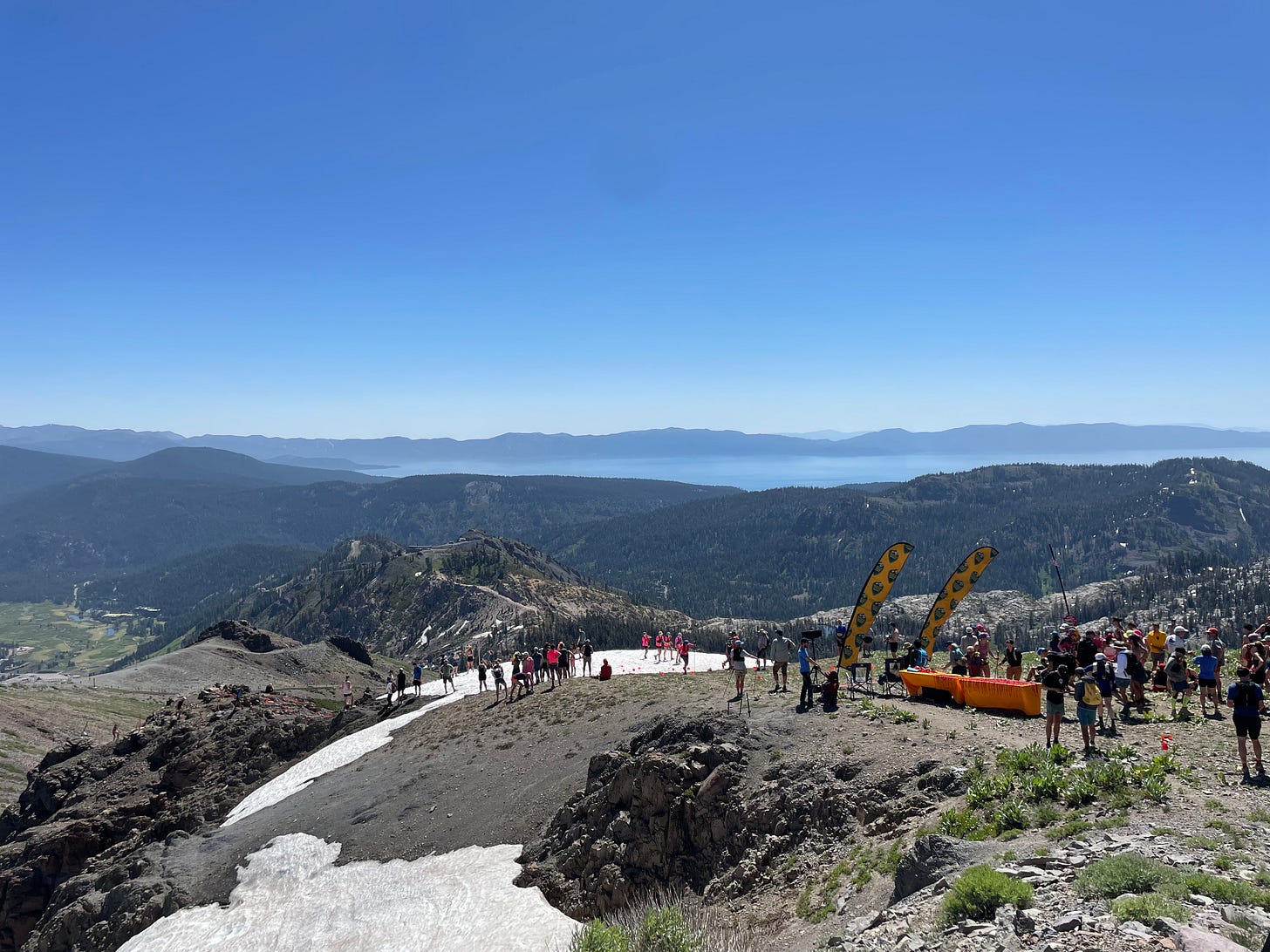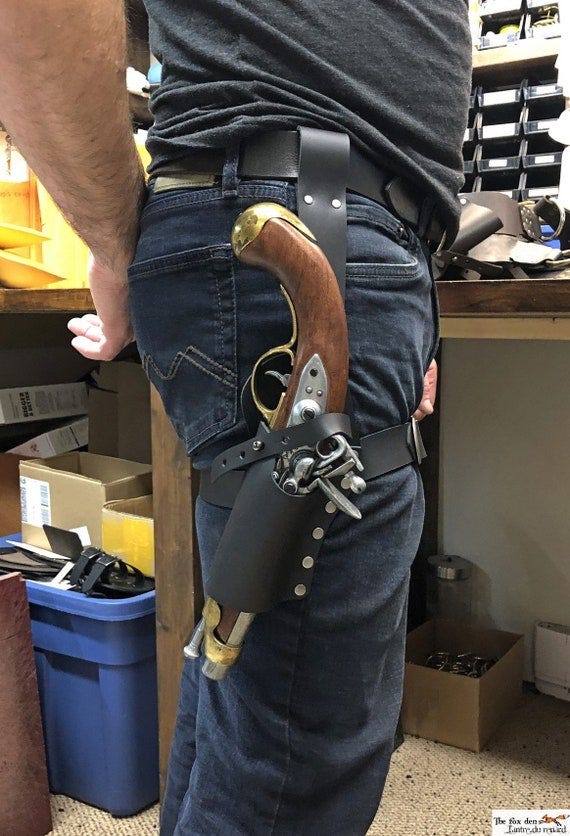Goin' Up to the Spirit (Finish Line) in the Sky
The Broken Arrow Sky Race and the Continued Rise of Trail Running
Two weekends ago, the annual Broken Arrow Skyrace events were held in the Olympic Valley just miles away from Lake Tahoe. I had the great fortune of participating in the “Vertical Kilometer” race, which involved ascending the Palisades ski resort from base to summit— about 1,000 meters (3,280 feet) of climbing— in just 3.7 miles. It was quite tiring to run/walk up a mountain as fast as possible, but as I ascended towards the finish line up an old metal ladder complete with a janky safety cable dangling by my side, the incredible views and cheering fans atop the snow-spackled peak made the effort worth it. I finished my race against the likes of ultramarathon legend Jim Walmsley by finishing a mere 33 minutes behind his 2nd-place finish of 37 minutes, though I am quite proud to say that I tied race winner Patrick Kipngeno on our descent back into the valley… in the same tram car.

My own race combined with the enjoyment and pride of watching my partner compete in the marathon event on Saturday (which would have ended my life most likely), reminded me of our last major trail race trip to Chamonix. I wrote about that experience, including the fun of attending trail races and the gear landscape of the sport. Since writing that article, I’ve continued to get more involved in trail running and following pros through their major races, and I can pretty confidently guess that trail running is going to explode in popularity in the years to come.
In particular, I left the Broken Arrow Sky Race with two thoughts that I wanted to dig deeper into. First, there are so many unique product design challenges in the world of trail racing that are ripe for innovation, and overcoming these challenges will help the sport expand. Second, any successful products (both old and new) in the sport may be poised for exponential growth as trail running continues to bloom. Of course, there’s no better way to organize thoughts than to force yourself to write an article about them, or so I’ve heard!
Convergent Product Design & The Marathon Du Mont-Blanc
At the end of June, I was lucky enough to travel to Chamonix to watch my wife run the Marathon Du Mont-Blanc trail race. The lead up to the race involved a taper-killing (or boosting) mix of mountain bikin…
In terms of product design opportunities, I really see two main areas where challenges unique to either trail racing or ultramarathons arise: Athlete Performance and Race Coverage (i.e. media). From Broken Arrow and the other recent trail events I’ve raced or followed, a few salient poorly-met user needs stick out in these areas, which are detailed below. Before jumping into the challenges though, it’s worth noting that a lot of people are drawn to, and compete in, ultramarathons and other trail races because they are challenging, and isolating, and wild, and rudimentary in terms of gear, so the product development suggestions here that either improve performance or make the sport more accessible to those looking to get involved aren’t necessarily recommendations for exactly how to proceed.
At the end of the day, if ultra running grows in popularity but loses its soul along the way, I don’t know how much of an achievement that would be!
Athlete Performance
Heat management. I wrote about thermal management in an article making predictions about the sports industry over the next five years. Over ultramarathon distances, and even shorter trail race distances in hot conditions, body heat management is possibly the most impactful factor on race outcome behind fitness— and the two are intertwined. So it still surprises me to see elite runners sporting vests that restrict airflow over the body, relying on aid station ice cubes down the back and in the hat, and wearing dark colors on sunny days. There have to be better ways for either athletes or race organizers to keep athletes cool, and anyone who cracks the code will have a hungry market of elite athletes.
Gear and nutrition hauling. In contrast to my point above, I often hear that running vests are the best means of carrying food, water, and gear like poles, extra layers, etc. I believe that is probably true for races where time between aid stations is far enough that runners need to carry multiple liters of water and a lot of food (i.e. less relevant for elite athletes), or races where the packing requirements are quite arduous— for example, the Jigger Johnson ultramarathon in New Hampshire where you need to carry layers, two liters of water, headlamps, reflective vests, and more to even race. However, I think that elite athletes are fast enough, and most races have dense enough aid stations, that a vest could be functionally replaced by a waist belt, or some new class of products like leg holsters, or cargo-oriented shorts. Honestly, innovations that solve this challenge could expand into hiking and general outdoor markets too. If fanny packs have made a come back, we shouldn’t count out any other small pack form factors.
Footwear. Super shoes ubiquitous in trail running, when? Trail runners are looking for the fastest shoe possible that provides enough stability to prevent injury, and a robust enough outsole to withstand the trail (in contrast to road super shoes that seem to have as small an outsole as possible to save weight). There are a wide variety of trail-oriented carbon-plated shoes on the market already, but I don’t know what the final form of super shoes for trail running looks like— do the shoes need to last a full 200-mile race? Should they be switched every 20 miles for peak performance? Should the plate be the same shape as a road running shoe? Answers to these questions will guide development in this area, and I think we may eventually end up with super trail shoes that perform quite differently from road running super shoes.

Race Coverage
For engaging fans following a race or individual athlete, having detailed updates and coverage is critical, if the goal is to attract and grow a sport and its following.
Filming. As opposed to road marathons, bike races, F1, track events, and other races where film coverage is relatively easy to execute with stationary, and motor vehicle-mounted cameras, trail races are very difficult to cover. There’s often poor cell coverage, river crossings, narrow trails, steep descents, uneven terrain, tree cover, and maybe most importantly, the race leaders are usually extremely spread out in the second half of a race, often by multiple miles. It’s possible there’s an elegant solution to provide ultramarathon fans video coverage of key events and athletes via drones, mountain bike-mounted cameras, aid stations with Starlink connections, or via other products. However, I think there could be some unique solutions to these challenges in products we haven’t dreamt of yet, and what form these take will depend heavily on what types and moments of coverage fans actually want.
Athlete tracking. Apart from aspirational live coverage of athletes, some ultramarathons struggle with the more fundamental challenge of providing fans and followers detailed information about where a given runner even is on a course. Most races use manual or chip-based timing at aid stations, but multiple hours often elapse between aid stations for non-elite athletes, and the timing systems can sometimes be unreliable. At long trail races, or those without aid station timing, I often use the “Find My” app to track my partner’s progress. This works remarkably well, except for areas with poor cell service— see: most mountain ranges where the races are actually held. I’m getting a bit crazy here, but I wonder if there is a way for race organizers to set up a local cell network or a large-scale passive RFID-based system to track athletes. We’re straying into military-esque technology here, but maybe that’s required!

In addition to these major areas, there are others like race logistics (e.g. trail marking, sign-up), that are ripe for new product design as well. Trail racing and ultramarathoning are veritable playgrounds of performance and media product design opportunities. But being a sport with users that have a lot of needs does not drive exponential growth on its own. Why do I think that trail running is poised for an explosion in the years to come?
First, I think all unique live events and races will continue to come at a premium as both general online and AI-based entertainment becomes more mainstream. Trail races and ultramarathons in different mountain ranges and canyons with varying weather conditions are nothing if not unique and make experiences worth sharing. In a similar structural perspective, I’m also a firm believer in the natural ebb and flow of the popularity of different sports. Particularly for non-major sports such as football, basketball, and soccer, relative popularity fluctuates wildly, and if cycling and skiing are booming now, post-pandemic, why not trail running and ultramarathoning next?
On a more tactical, sport-focused level, I believe that trail running of any distance is leaps and bounds more entertaining and fulfilling than road running. A knotted, hilly, rocky, trail where you can run fast but need focus on footwork is a much more engaging than a paved sidewalk next to a busy road. Trail running anywhere, even if it’s in a small park or town trail just outside a city really helps you disconnect from every day life in a way that I don’t think many other sports can. The natural beauty of any mountain trail far outweighs most road runs, and you have the added benefit of attending races in beautiful locations (funding—dependent, which is a topic for a future article but worth mentioning). I’ve much more enjoyed running and spectating in places like the White Mountains in New Hampshire, and the Sierra Nevadas in California than on a crowded sidewalk in Philadelphia (no offense to the city of brotherly love, of course, but full offense to the Eagles).
Maybe most importantly, trail running simply hasn’t experienced exponential growth yet, which makes it much easier to achieve now. In looking at the Google Search Trends for trail running as a search term, you can see a relatively steady, linear increase in popularity over time, with the classic seasonal fluctuations that accompany most sports:
When you compare trail running to the popularity of more traditional road running via the search trends for “Trail Shoes” and “Running Shoes” you can see that both have enjoyed relatively steady growth, though with “Trail Shoes” having a consistent 1/10th the engagement of “Running Shoes",” which to me indicates that a plausible narrowing of this gap would signal massive boosts in trail running participation and associated gear sales.
If you were curious at all, this is what the Google Search Trends for Pickleball look like— I figured it would be an example of steady growth into an exponential explosion of popularity, and that was correct:

The Pickleball example is both entertaining and somewhat informative about how quickly modern sports can explode in popularity. I would imagine that “Iron Man” has a similar, maybe slightly steadier growth trajectory (if you remove the movie mentions), and I strongly believe trail running might follow a similar trend in the years to come. The sport is exciting and meditative to watch in person and on TV, you get to visit incredibly beautiful destinations if you race or support others in person, and the varied terrain is very enjoyable to traverse and run through once you get over the fear of running quickly downhill, at least.
If you get the chance to participate in any form of trail race, from a vertical kilometer to a 100-mile ultramarathon, or cheer a friend through one, I recommend you take the opportunity. At best, you achieve or witness an athletic feat and exciting race in great weather in a beautiful landscape, and at worst, you have an incredible story to tell others about battling the elements up a mountain through rain and a mudslide. And don’t worry about where you start your trail running journey— like I mentioned, even a short trail through a local town is a great way to start. It’s a no-lose scenario. As long as you don’t get injured or endure the worst Chaco sandal sunburn of all time, like I did in Tahoe, there are no downsides.








